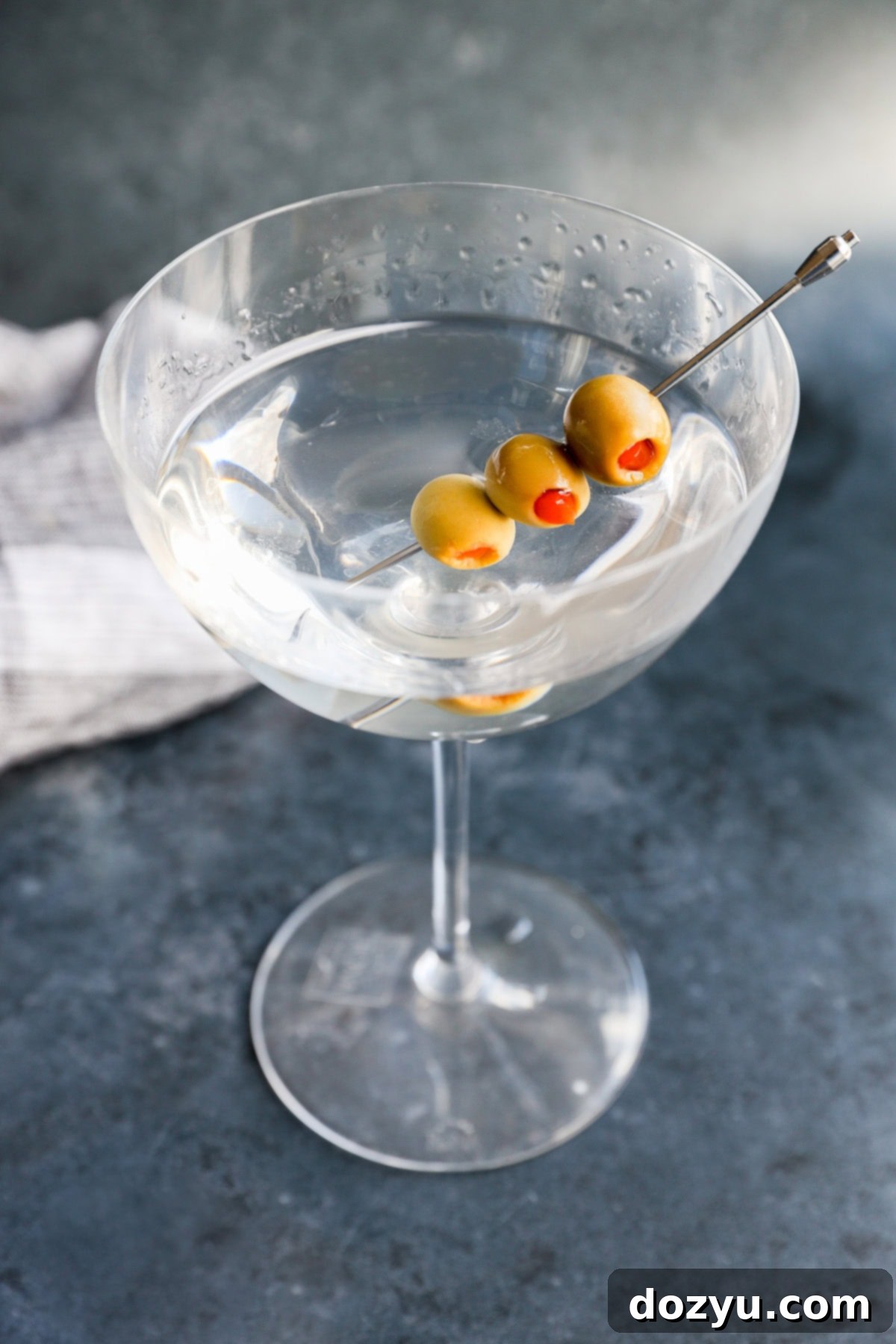Master the Classic Gin Martini: A Timeless Cocktail Guide
When it comes to the world of cocktails, few drinks command as much respect and admiration as the Gin Martini. This iconic libation, celebrated for its elegant simplicity and sophisticated flavor profile, stands as a true testament to the art of mixology. Blending the crisp botanicals of a quality gin with the subtle, aromatic whispers of dry vermouth, the Gin Martini is more than just a drink; it’s an experience, perfect for winding down after a long day or elevating any social gathering. Its timeless appeal makes it a versatile choice for both casual happy hours and formal dinner parties, effortlessly exuding class and refinement.
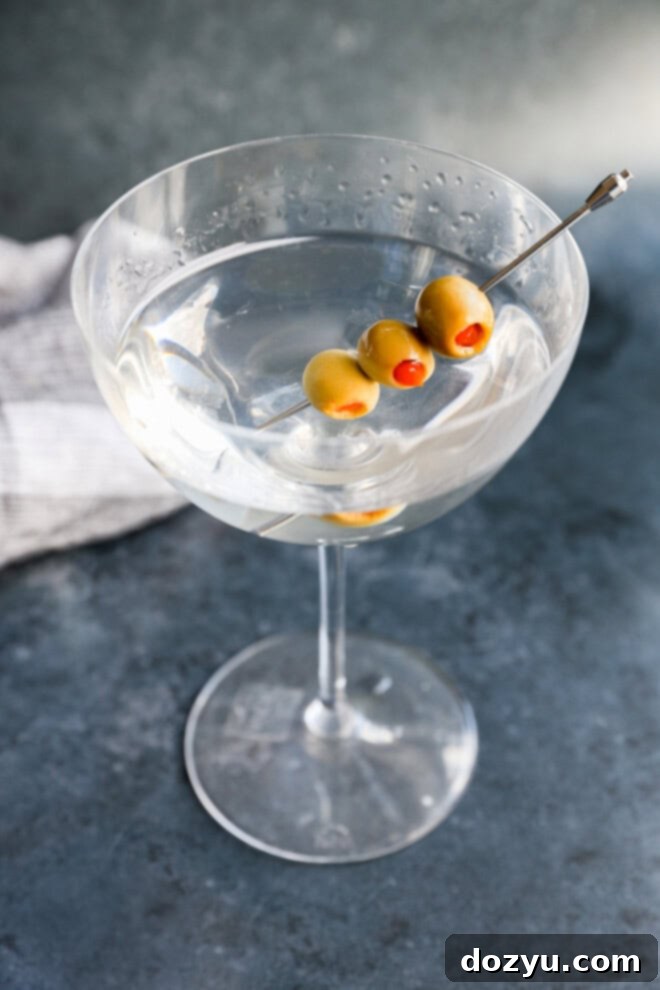
Table of Contents
Toggle
About the Classic Gin Martini
This effortlessly elegant and incredibly simple gin martini recipe is your perfect gateway into the sophisticated world of classic cocktails. You don’t need years of mixology experience to craft a superb drink; this recipe empowers you to highlight the exquisite qualities of your chosen gin while allowing you to fine-tune the dry vermouth ratio to your exact preference. From its mysterious origins in the late 19th or early 20th century to its enduring status today, the Martini has remained a symbol of refined taste and a benchmark for any serious cocktail enthusiast.
The beauty of the gin martini lies in its approachable yet versatile nature. It’s remarkably quick to prepare, making it an ideal choice for impromptu gatherings or a sophisticated start to a carefully planned evening. This recipe’s true strength is its adaptability. With minimal adjustments, you can transform it into a bone-dry, wet, or even a savory dirty martini, perfectly tailored to your palate. Its adaptability ensures that whether you’re a purist or prefer a modern twist, the classic framework remains deeply satisfying.
Moreover, achieving martini mastery doesn’t require an elaborate home bar. Armed with a high-quality gin, a bottle of fresh dry vermouth, and a few basic bar tools, you’ll be shaking or stirring up your perfect martini in mere minutes. It’s a testament to the power of quality ingredients and simple techniques, proving that sometimes, the best things in life are indeed the simplest.
Shake or Stir: The Martini Debate
Ah, the age-old question that sparks lively debate among cocktail aficionados: should a martini be shaken or stirred? The traditionalist view, famously championed by James Bond himself (though he specified a Vesper Martini with gin and vodka, not a pure gin martini), dictates that a gin martini should always be stirred. This method is preferred for spirit-forward cocktails like the gin martini because it yields a crystal-clear drink with a silky-smooth texture and precise dilution. Stirring gently chills the ingredients without introducing air bubbles, preserving the drink’s pristine appearance and delicate mouthfeel.
Shaking, on the other hand, is a more aggressive chilling method. It introduces more air, resulting in a slightly cloudier appearance and a different texture due to aeration. Shaking also typically leads to greater dilution, as the ice breaks down more quickly from the vigorous movement. However, some prefer the bone-chilling cold and the slightly frothy texture that shaking imparts. Personally, while tradition leans towards stirring, I often find myself gravitating towards a shaken martini for that extra chill and subtle aeration!
Ultimately, the choice comes down to personal preference. If you prioritize visual clarity, a smooth texture, and minimal dilution, a gentle stir is your best bet. If you crave an exceptionally cold drink with a slightly lighter body and don’t mind a touch of cloudiness, feel free to shake to your heart’s content. Experiment with both methods to discover which “perfect” martini truly aligns with your taste.
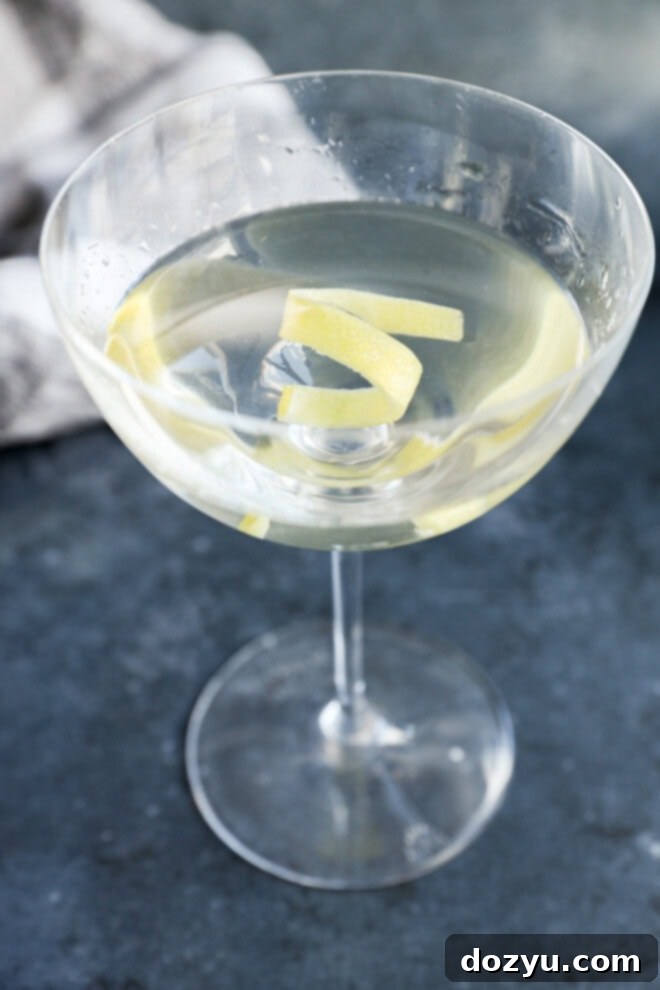
Essential Gin Martini Ingredients
A classic gin martini relies on just a few key ingredients, making their quality paramount to the final result. Choosing wisely ensures a truly exceptional cocktail.
Gin: The Heart of the Martini. As the star of this timeless cocktail, your choice of gin will largely define its character. Opt for a gin you genuinely enjoy sipping on its own, as its flavors will be front and center. For a crisp, juniper-forward profile that is quintessential to a classic martini, a London Dry gin is ideal. Brands like Tanqueray or Beefeater are superb choices, offering a robust botanical backbone. If you lean towards something a bit more nuanced and aromatic, a New Western Dry gin like Bombay Sapphire or The Botanist will provide a softer, more floral, or citrusy experience. Plymouth Gin is another excellent option, known for its slightly sweeter, earthier profile compared to London Dry.
Dry Vermouth: The Soulmate. This fortified wine is crucial for adding herbal, floral, and subtle citrus notes that beautifully balance the gin’s intensity. Dry vermouth isn’t just a filler; it’s a critical aromatic component. Dolin Dry is a widely respected, all-purpose option with delicate, clean flavors that won’t overpower the gin. For those who prefer a slightly richer, more robust profile that can stand up to a bolder gin, Noilly Prat Dry Vermouth is an excellent choice. Remember, vermouth is wine-based and will oxidize once opened, so always store it in the refrigerator and try to use it within a month or two for optimal freshness. An old, oxidized vermouth can ruin even the finest gin.
Garnish: The Finishing Touch. While not an ingredient mixed into the drink, the garnish plays a vital role in the martini experience. A simple lemon twist provides bright, zesty citrus oils that add a fragrant aroma and a subtle counterpoint to the gin’s botanicals. Alternatively, a cocktail olive or two introduces a savory, briny kick, especially popular in a “dirty” martini.
Must-Have Tools for the Perfect Martini
Crafting a truly exceptional martini, one that is perfectly balanced and exquisitely chilled, relies on a few essential bar tools. These aren’t just accessories; they are non-negotiable for achieving that professional touch.
- Jigger: Precision is paramount in cocktail making, especially for a spirit-forward drink like the martini. A jigger allows for accurate measurement of both gin and vermouth, ensuring the perfect ratio and preventing an unbalanced drink. This small tool is what truly separates a good martini from a great one.
- Cocktail Shaker or Mixing Glass: This is where the magic happens. A sturdy cocktail shaker is essential for rapidly chilling your martini and achieving a slight dilution that softens the alcohol’s edge. If you prefer the traditional stirred method for maximum clarity, a tall mixing glass with a thick base is ideal. Both options ensure your drink reaches the perfect icy temperature.
- Cocktail Strainer: To seamlessly pour your perfectly chilled martini into its glass while leaving behind any ice shards or garnishes, a quality cocktail strainer is indispensable. A Julep strainer works well with a mixing glass, while a Hawthorne strainer is perfect for a shaker.
- Martini Glasses (or Coupe Glasses): The vessel itself contributes significantly to the martini experience. Serving your drink in a chilled, elegant martini or coupe glass isn’t just about aesthetics; it helps maintain the cocktail’s cold temperature and enhances the overall sophistication. Always chill your glasses beforehand – a freezer is ideal, or fill them with ice and water while you prepare the drink.
Together, these fundamental tools ensure that every martini you craft is a masterpiece of balance, temperature, and presentation.
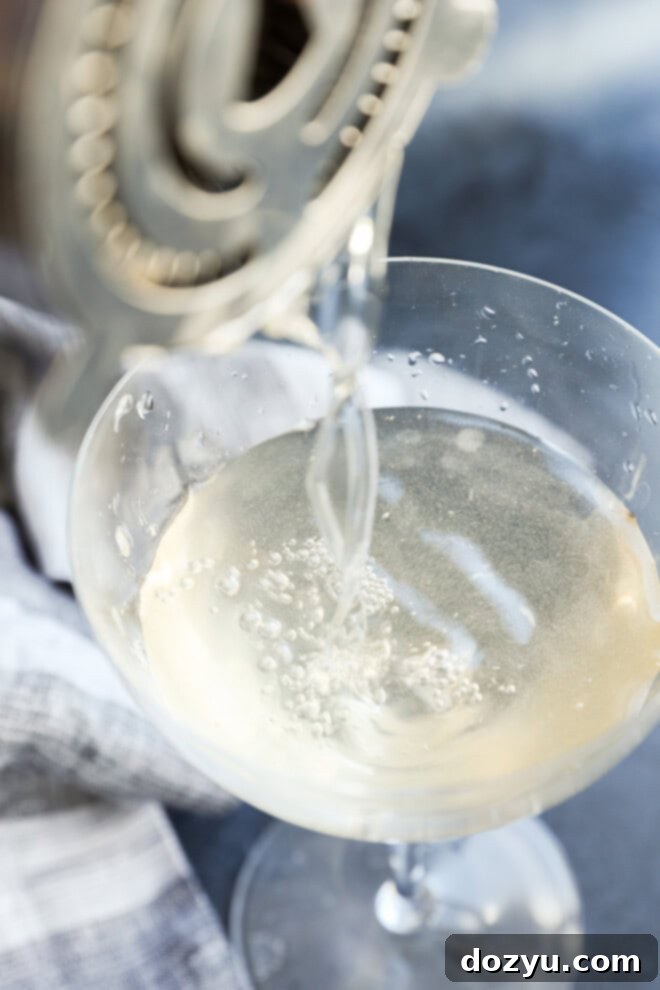
How to Craft Your Classic Gin Martini
Follow these simple steps to create a perfectly balanced and chilled gin martini:
1. Chill the Glass
Begin by filling your chosen martini or coupe glass with ice cubes and cold water. This crucial step ensures your drink stays perfectly chilled and crisp from the first sip to the last. Set the glass aside while you prepare your cocktail mixture.
2. Combine and Mix Ingredients
Measure your preferred gin and dry vermouth using a jigger. Add these ingredients to a cocktail shaker filled generously with fresh ice. If you prefer a shaken martini, close the shaker tightly and shake vigorously for about 15-20 seconds. This ensures optimal chilling and slight aeration. If you opt for a stirred martini, combine the ingredients in a mixing glass filled with ice. Stir gently but continuously with a bar spoon for 30-45 seconds until the mixture is thoroughly chilled and slightly diluted.
3. Prepare Your Serving Glass
Once your cocktail mixture is ready, discard the ice water from your chilled martini glass. This leaves a perfectly frosty vessel, ready to receive your masterpiece.
4. Strain and Present
Place a cocktail strainer over your shaker or mixing glass. Carefully pour the chilled cocktail mixture directly into the prepared, frosty martini glass. The strainer will hold back any ice, ensuring a clean and smooth pour.
5. Add the Perfect Garnish
Complete your martini with a chosen garnish. A lemon peel, expertly twisted over the drink to release its fragrant oils, adds a bright citrus note. Alternatively, one or three cocktail olives (never two, it’s considered bad luck!) provide a savory, briny counterpoint. Serve immediately and savor the timeless elegance!
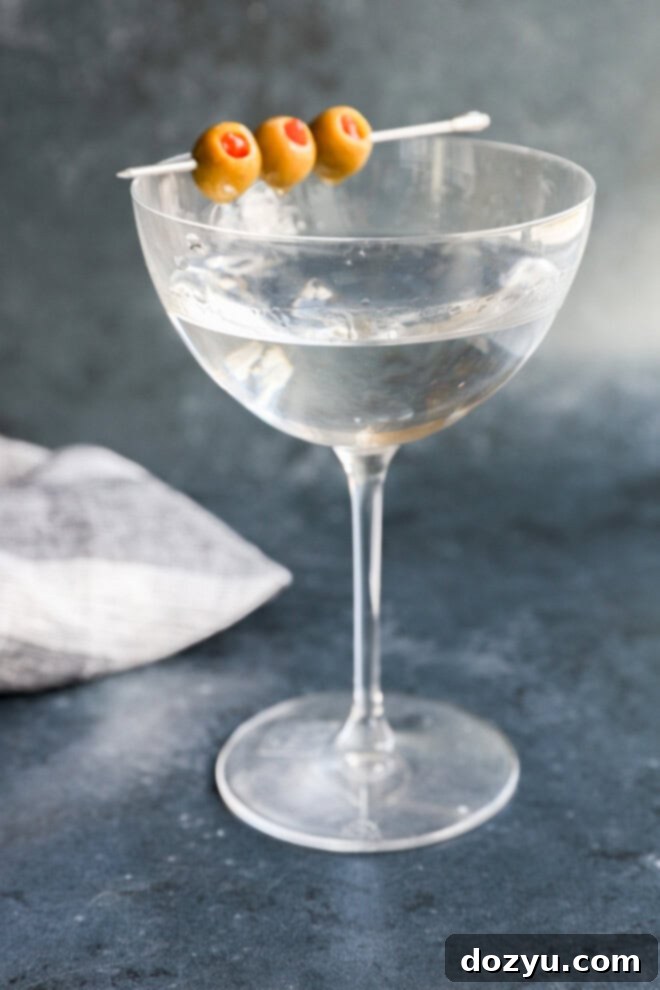
Expert Tips and Tricks for Martini Perfection
Achieving martini perfection is all about attention to detail. Here are some expert tips to elevate your homemade gin martini:
- Pre-Chill Everything: This cannot be stressed enough. For the ultimate gin martini, ensure your gin, vermouth, and especially your glassware are thoroughly chilled before you begin mixing. Storing your gin in the freezer for at least an hour (or even indefinitely) will make a noticeable difference in the final temperature and chill factor of your drink.
- Quality Over Quantity: Since a martini has so few ingredients, the quality of each is paramount. Invest in a good quality gin that you genuinely enjoy and always use fresh dry vermouth. Old, oxidized vermouth can impart unpleasant flavors that will spoil your martini. Store vermouth in the refrigerator after opening and aim to use it within a month or two.
- Control Your Dilution: Whether you shake or stir, the goal is optimal chilling with just the right amount of dilution. Too little dilution results in an overly potent drink; too much makes it watery. Use large, solid ice cubes that melt slower. If stirring, aim for 30-45 seconds. If shaking, 15-20 seconds is typically sufficient.
- Experiment with Ratios: The “perfect” gin-to-vermouth ratio is highly personal. Start with a classic ratio (e.g., 2:1 or 5:1 gin to vermouth) and then adjust. Do you prefer a drier martini? Reduce the vermouth. A wetter one? Increase it slightly. Don’t be afraid to experiment to find your ideal balance.
- Garnish Wisely: Your garnish isn’t just decoration; it’s an aromatic component that can drastically alter the drink’s character. A lemon twist, properly expressed to release its oils, adds bright, fresh citrus notes. Olives, particularly in a dirty martini, lend a savory, briny quality. For olives, choose high-quality ones and use them sparingly – two or three are usually plenty to prevent overpowering the delicate gin and vermouth flavors.
By following these tips, you’ll be well on your way to consistently crafting outstanding gin martinis that impress both yourself and your guests.
Gin Martini Variations to Explore
The beauty of the gin martini lies in its versatility. With simple tweaks, you can create a range of experiences tailored to different preferences:
- Dry Gin Martini: This is the classic interpretation, where a small amount of dry vermouth is used to complement, rather than mask, the gin’s robust botanical flavors. It’s perfect for those who appreciate the crispness and complexity of gin. Garnish with a lemon twist or an olive to enhance its aromatics. This is the foundational recipe often seen in bars.
- Bone Dry Martini: For the ultimate purist, this variation minimizes vermouth to the extreme. Some recipes suggest merely rinsing the glass with vermouth before discarding it, or even omitting it entirely. The focus here is solely on the gin, undiluted and bold. A lemon twist is the traditional garnish, adding a hint of fresh aroma without altering the flavor significantly.
- 50-50 Martini (Wet Martini): A resurgence in popularity, this variation combines equal parts gin and dry vermouth. The higher vermouth content creates a smoother, more herbal, and slightly sweeter profile, balancing the gin’s botanicals with the vermouth’s complex notes. Garnish with an orange or lemon twist for an added citrusy lift.
- Dirty Martini: A favorite among savory cocktail lovers, the dirty martini includes a splash of olive brine. This addition imparts a salty, umami kick that perfectly complements the gin. For an indulgent touch, garnish with blue cheese-stuffed olives.
- Perfect Martini: This variation incorporates both dry and sweet vermouth, typically in equal parts, to create a more rounded and nuanced flavor profile. The sweet vermouth adds a touch of richness that mellows the dryness, offering a complex yet approachable martini.
- Gibson Martini: While structurally similar to a classic martini (gin and dry vermouth), the Gibson is distinguished by its unique garnish: one or more pickled cocktail onions. This provides a sharp, savory, and slightly piquant flavor that stands out from the traditional olive or lemon twist.
More martini recipes: Cucumber Martini | Limoncello Martini | Espresso Martini | Fresh Apple Martini
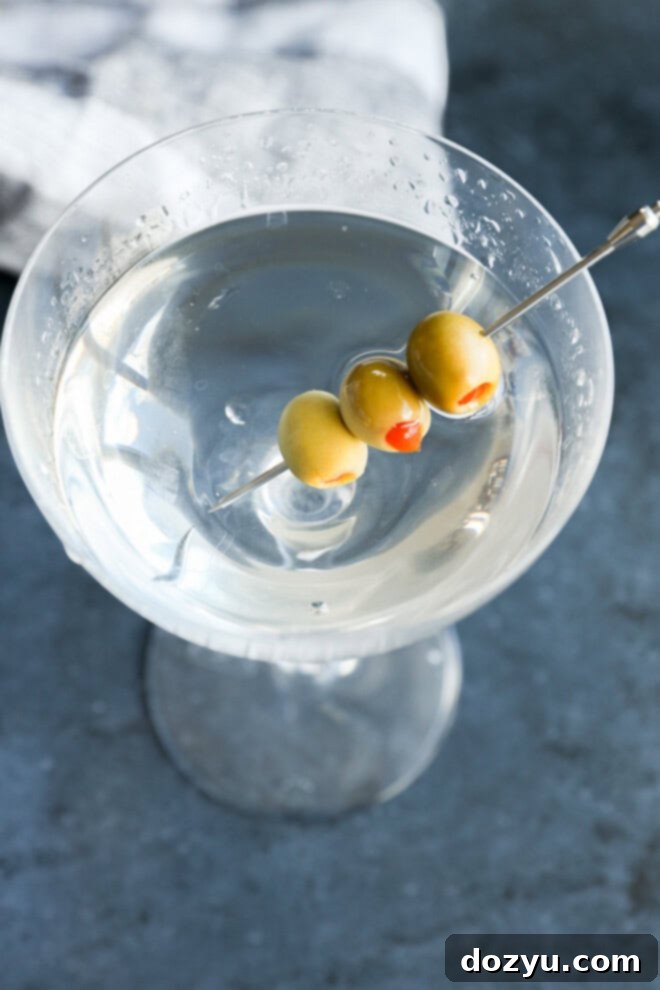
Beyond the Martini: Popular Gin Cocktails
Gin’s botanical complexity makes it an incredibly versatile spirit, lending itself to an almost endless array of cocktails beyond the classic martini. If you’re looking to explore gin further, here are some popular and distinct options:
- Gin and Tonic: The quintessential refreshing gin cocktail, combining gin with tonic water and a citrus garnish (lime or lemon). It’s simple, effervescent, and perfect for any occasion.
- Negroni: A bold, bittersweet Italian classic made with equal parts gin, Campari, and sweet vermouth. It’s stirred and typically garnished with an orange peel.
- Tom Collins: A light and refreshing highball cocktail featuring gin, lemon juice, simple syrup, and soda water, often garnished with a lemon slice and a cherry.
- Gin Fizz: Similar to a Tom Collins but with the addition of egg white, which creates a frothy, silky texture. It’s shaken hard and topped with soda water.
- French 75: An elegant and celebratory cocktail that blends gin, lemon juice, simple syrup, and champagne, often served in a champagne flute.
- Southside: A vibrant and refreshing drink with gin, lime juice, simple syrup, and muddled mint, often shaken vigorously.
- Aviation: A beautiful, floral cocktail with gin, maraschino liqueur, crème de violette (giving it a light purple hue), and lemon juice.
Each of these cocktails showcases gin’s diverse flavor profiles, from juniper-forward to citrusy, herbaceous, or floral, proving its adaptability in the cocktail world.
Gin Alternatives in Cocktails
While gin holds a special place in the cocktail canon, there are indeed many excellent alternatives if you’re looking to explore different flavor profiles or simply don’t have gin on hand. Substituting gin often transforms the cocktail entirely, creating a new, exciting experience:
- Vodka: The most common alternative, especially in martinis. A Vodka Martini (often called a “Vodkatini”) offers a cleaner, smoother, and less botanical profile than its gin counterpart. Vodka can also be swapped into drinks like a Gimlet for a refreshing, citrus-forward twist.
- Tequila: For a vibrant, agave-forward kick, tequila can be an intriguing substitute. Imagine a Tequila Negroni or a Tequila Sour. Its earthy, peppery notes offer a distinctly different character to any cocktail.
- Rum: Depending on whether you choose light, dark, or aged rum, you can introduce a spectrum of flavors from sweet and grassy to rich and caramelized. Rum can work surprisingly well in some gin-based recipes, creating tropical or warm variations.
- Whiskey (Bourbon/Rye): While often the star of its own classic cocktails, whiskey can also step in as an alternative, particularly in stirred, spirit-forward drinks where its robust character can shine. Consider a Boulevardier (a whiskey-based Negroni) for a warmer, spicier take.
- Mezcal: For an adventurous palate, mezcal offers a smoky, complex profile that can add incredible depth to cocktails. Its distinct flavor means it’s not a direct swap, but it opens up a world of creative possibilities for unique, smoky drinks.
Experimenting with different spirits in familiar cocktail structures is a fantastic way to broaden your palate and discover new favorite drinks.
The Stir vs. Shake Debate: A Deeper Dive
The method of preparing a gin martini — stirred versus shaken — is a point of contention and tradition. Conventionally, spirit-forward cocktails like the gin martini are stirred. The primary reason for this is to achieve the desired chilling and dilution without compromising the drink’s clarity or texture. Stirring over ice results in a smoother, more viscous mouthfeel and keeps the martini crystal clear, which is highly valued by purists.
When you shake a drink, you introduce more air, causing aeration and tiny ice shards to break off into the liquid. This often results in a slightly cloudy appearance and a lighter, frothy texture. Shaking also typically leads to a colder drink with more dilution, as the ice melts faster due to the violent agitation.
So, do you *need* to stir your gin martini? While tradition and purists would strongly advise it for the reasons mentioned above, ultimately, it comes down to your personal preference. If you enjoy a very cold drink with a slight cloudiness and don’t mind a bit more dilution, then shaking is perfectly acceptable. However, for that classic, elegant, and smooth gin martini, stirring is the preferred method.
A simple rule of thumb often applies: If your cocktail contains only spirits (like gin and vermouth in a classic martini), stir it. If it includes ingredients like fruit juices, dairy, cream, or egg whites, shaking is usually the best approach, as these ingredients benefit from the aeration and more thorough mixing that shaking provides.
Need some inspiration for your next party? Check out my booze recipes page!
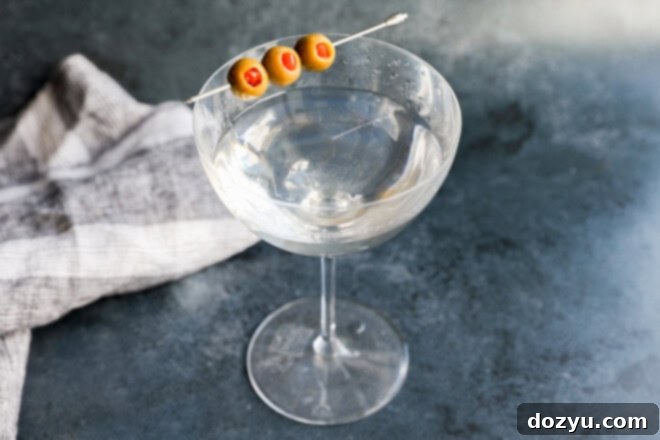
Perfect Pairings: What to Serve with Your Gin Martini
A perfectly crafted gin martini is a sophisticated aperitif, setting the tone for a delightful evening. Its crisp, dry, and often savory profile pairs beautifully with a range of foods, from simple snacks to hearty main courses. Here are some ideal accompaniments:
- Salty Snacks: The dry, bracing nature of a martini is perfectly complemented by salty flavors. Keep it effortlessly elegant with a bowl of high-quality Marcona almonds, perfectly salted mixed nuts, or gourmet kettle chips. For something a bit more substantial and impressive, consider homemade Prosciutto Cheese Twists or crispy, savory Crispy Prosciutto.
- Artisan Cheese Boards: The complex flavors of aged cheeses provide a wonderful contrast to a martini. Opt for firm, savory cheeses like an aged Gouda, nutty Manchego, or a sharp cheddar. These cheeses can stand up to the martini’s potency without being overwhelmed. Explore creating an Easy Charcuterie Board or a lavish Italian Charcuterie Board for inspiration, adding olives, cornichons, and crusty bread.
- Savory Appetizers: Classic pairings that match the martini’s timeless appeal. Elevate your appetizer game with savory baked crab cakes, rich deviled eggs, or the ever-popular shrimp cocktail. For an extra touch of decadence, try our favorite Pan-Seared Scallops served with an indulgent bacon cream sauce.
- Elegant Dinner Pairings: Few combinations are as iconic and satisfying as a martini with a perfectly cooked steak. The clean, potent flavors of the martini cut through the richness of the meat, cleansing the palate with each sip. Pair your martini with a succulent Grilled New York Strip Steak or a perfectly prepared Perfect Ribeye Steak for a truly luxurious dining experience.
Choosing the right accompaniment can transform your martini from a simple drink into a memorable culinary moment.
Explore More Gin Cocktail Recipes
Now that you’ve mastered the foundational elements of the classic gin martini, it’s time to unleash your creativity and explore the vast world of gin cocktails. Whether you’re perfecting a dry martini for a truly classic sip or venturing into a savory dirty version, this recipe serves as the ideal springboard for all your gin adventures. Gin’s botanical range means there’s always something new to discover!
For a burst of refreshing flavor, try the Blackberry Gin Fizz. This delightful concoction marries the bold, sweet-tart essence of blackberries with the crisp, aromatic qualities of gin, creating a perfectly balanced and effervescent fizz that’s ideal for any season or celebration.
If your mood calls for something sweet, fruity, and utterly delightful, the Strawberry Gin Smash Cocktail is an absolute must-try. It expertly blends fresh, ripe strawberries with premium gin, resulting in a vibrant, easy-to-make drink that bursts with summery goodness and a beautiful hue.
Or, for those who appreciate timeless sophistication, revisit the Gin Sling. This smooth and incredibly versatile cocktail beautifully combines the rich, complex botanical notes of gin with a refreshing hint of citrus and a touch of sweetness, offering a refined and deeply satisfying sip that never goes out of style.
Everyday Seasonal Cookbook
With seasonal produce guides, recipes, and more, this cookbook is filled with seasonal food for every occasion.
Finally, if you make this gin martini recipe, please be sure to give this recipe a star recipe rating on the recipe card and/or leave a comment! I love to hear when you all make recipes, and I do take the time to respond to every single comment.
Feel free to drop questions below too, if you have them!
Oh and be sure to tag me on Instagram, Facebook, or Pinterest if you make the recipe! I love being able to see these recipes come to life in your homes – it’s my favorite thing to look through those photos. It really means the world to me!
Want to know when I come out with a new recipe or the latest news? Sign up for my newsletter to get them straight to your inbox!
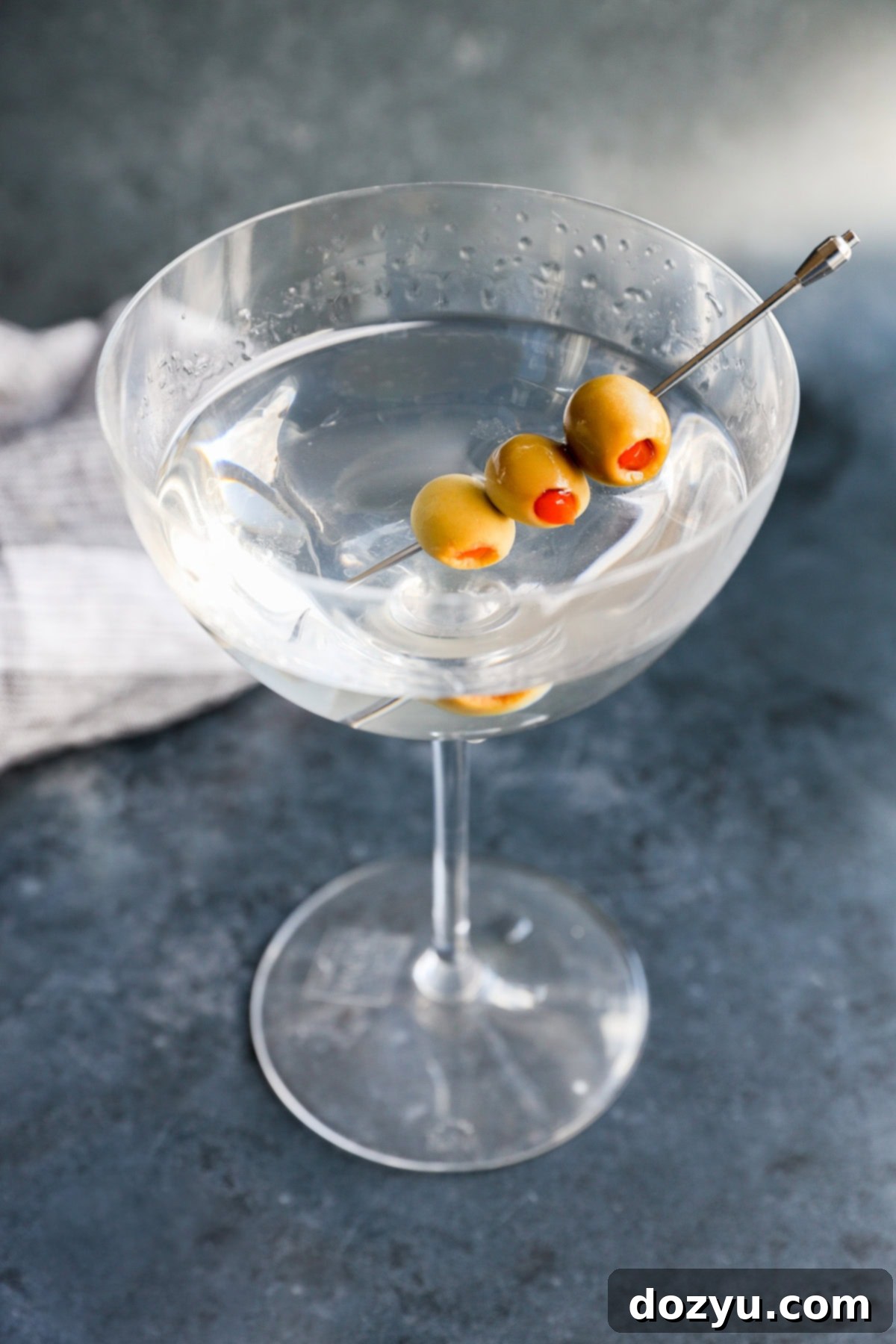
Gin Martini
Equipment
-
Jigger
-
Cocktail Shaker
-
Cocktail Strainer
-
Martini Glasses
Ingredients
- 2 ounce Gin chilled
- ½ ounce Dry Vermouth chilled
Instructions
-
Fill a cocktail glass with ice and cold water to chill it while you prepare the drink.
-
Add gin and dry vermouth to a cocktail shaker filled with ice.
-
Shake vigorously for about 20 seconds, until well chilled.
-
Discard the ice water from the cocktail glass.
-
Strain the cocktail mixture into the chilled glass.
-
Garnish with a lemon twist or a cocktail olive, and serve immediately.
Video
Nutrition
